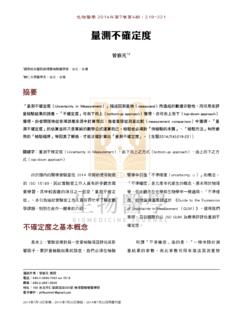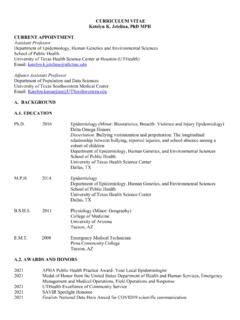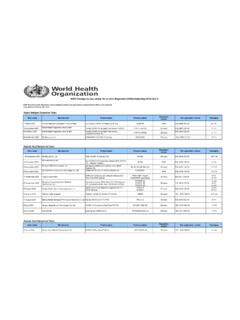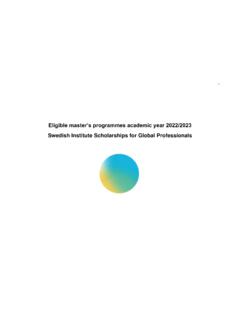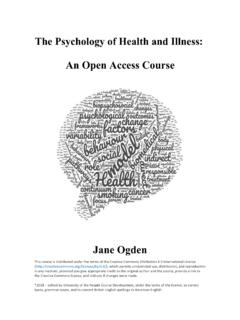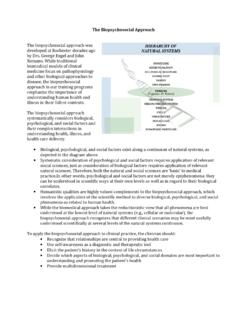Transcription of Biomedicine - SAGE Publications Inc
1 1 BiomedicineKey issues The way we think about health and illness today reflects a way of thinking that dates back to the nineteenth century; it is known as the biomedical model The biomedical approach to health and illness has strengths but also weaknesses; it over-simplifies health problems in particular ways Health care practice today reflects the influence of the social and biopsychosocial models of health, which emphasize psychological and social factors influencing health and illness IntroductionWhen you think about health care, what images come to mind? You may picture uniforms and sterile floors, white coats, plastic gloves and patients lined up in bed. It seems like common sense to think about health in this way. However, this way of thinking about health is fairly recent. Our twenty-first century ideas about health can be traced back to the nineteenth century and the rise of an approach to human health that we now call bio-medicine.
2 Looking at the early history of Biomedicine can help us to stand 607-Nov-13 1:46:34 PMBiomedicine7back from our own experience of health and health care and think about what health means from a wider perspective. Biomedicine , biomedical model: an approach to health and illness which defines illness as the absence of disease, portraying the human organ-ism as either functioning normally or else dysfunctional and therefore Short History of MedicineOur society still places great value on science and a scientific approach to problems, seen as rational, objective and unbiased. But for most of human history people did not aspire to being scientific . In medieval Europe, life revolved around the church, and society was dominated by religious ideas. People believed that the source of knowledge was God. Knowledge should only be acquired through God s agents on earth, priests, who were morally equipped to interpret the word of God as expressed in the Bible.
3 To tamper with nature was seen as immoral, because nature existed as it did because it was God s will . Ideas about human health were situated within this framework. For example, people who had visual and auditory hallucina-tions and would today be diagnosed as suffering from schizophrenia were considered to be possessed by demons. Health care, for those who could afford it, was carried out by a variety of healers who might have quite dif-ferent ideas about how to effect a cure (Elmer, 2004). By the sixteenth and seventeenth centuries, European society was chang-ing in a way that would affect the rest of the world. One person who was important in the development of new ideas was Ren Descartes (1596 1650), often referred to as the founder of modern philosophy. Descartes is signifi-cant in relation to health because he was the most important thinker to articulate clearly a view which suggested that the mind and the body are two separate spheres.
4 He argued that the body could be seen as part of the phys-ical world and the mind as part of the spiritual world (see Figure ). The mind and body are connected, but separate. This idea was an important 707-Nov-13 1:46:34 PMSOCIOLOGY FOR HEALTH PROFESSIONALS8milestone on the road towards the development of modern medical ideas, or Biomedicine . The body was identified as the location for illness and part of the physical world. This was one step towards using scientific methods to try to understand how the body works and towards ending the former reluc-tance to interfere with the course of nature (Seymour, 1998; Engel, 1977).Descartes ideas fitted with a new understanding of the world that would allow thinkers to engage in scientific experimentation without being labelled dangerous enemies of God. New social forces were emerging in society. These included manufacturers, small scale at first, who were increasingly motivated to develop new, faster and cheaper ways to produce things that would make them a profit in the marketplace.
5 Over the course of several centuries, these new social forces became associated with enthusiasm for science and an intellectual movement now known as the Enlightenment. It is usually dated as starting in the late part of the seventeenth century and ending in 1800 at the beginning of the nineteenth century (you will read more about this in Chapters 2 and 3). Enlightenment thinkers celebrated reason and rationality over superstition. They valued scientific methods of Figure Note in Descartes Essai sur l homme the location of the soul, a teardrop shape inside the brain, seen as the controller of the bodyCourtesy of Historical Collections & Services, Claude Moore Health Sciences Library, University of 807-Nov-13 1:46:34 PMBiomedicine9investigation observation and experimentation rather than religious authority. The following seventeenth-century text shows the influence of machine imagery in the views of early anatomists as they peered over corpses, trying to understand the workings of the human body: Whoever examines the bodily organism with attention will certainly not fail to discern pincers in the jaws and teeth: a container in the stomach: water-mains in the veins, the arteries and other ducts; a piston in the heart; sieves or filters in the bowels; in the lungs, bellows; in the muscles, the force of the lever; in the corner of the eye, a pulley, and so on.
6 (Synnott, 1993: 23)The Nineteenth-century Rise of Biomedicine Biomedicine rapidly came to dominate approaches to health care over the course of the nineteenth century. This new scientific approach to health was associated with the rise of university medical training to ensure practitioners were experts in the science of medicine. Increasingly, the laboratory became the appropriate venue for medical research. The status of doctors and medical professionals increased as they formed their own organizations to set stand-ards about who should and should not be allowed to practice health care (more about this in Chapter 10). As the medical establishment consolidated its influence in society, a variety of healers on the margins including herbalists and midwives were pushed aside (Lawrence, 1994; Brunton, 2004). With the rise of Biomedicine , patients experience of medical care changed fundamentally. Where health care had been mainly carried out by traditional local healers at home, hospitals, places set aside especially for the treatment of the sick, now became the important site for health care (Jewson, 1976).
7 In a society ever more focused on the idea of people as individuals, health care came to be about a relationship between two individuals: the medical expert, responsible for their individual conduct according to the standards of their profession, and the patient, responsible for monitoring their own health, reporting any problems and complying with the expert advice pro-vided by the doctor (Gabe et al., 2004: 125). Characteristics of BiomedicineBiomedicine, the new scientific approach to medicine, was based on an underlying set of ideas about health that has been called the biomedical 907-Nov-13 1:46:34 PMSOCIOLOGY FOR HEALTH PROFESSIONALS10model . That model rests on some key assumptions about the human body, health and illness. Four are discussed Body as a MachineThe simplest feature of the biomedical model is that it describes the body as if it were a machine. Anatomy was a particular interest in the nineteenth century, and there was great competition to obtain human bodies to dissect and study.
8 The early doctors were enthusiastic to discover the mechanical way that the parts of the body work together. Consequently, an important characteristic of the biomedical model is to treat the body as a machine. Sarah Nettleton labelled this feature the mechanical metaphor (2006). The body is imagined in Biomedicine as if it were a machine. Mechanical metaphor: a feature of the biomedical model of illness that portrays the human body as functioning essentially like a DualismThe biomedical model reflects the influence of the philosopher Descartes, men-tioned earlier. Descartes was interested to understand the nature of human beings and consciousness and the relationship between the mind and the body. He suggested that we could distinguish between a person s brain and their mind, which are related, but not the same. Our ideas, beliefs and values cannot be reduced to biology, but belong to another realm. The body is governed by physical laws, but is also controlled by the mind (see Figure ).
9 This idea was essential for Biomedicine to develop. However, it can also be associated with a view that emotions and beliefs matters of the mind were of secondary importance when it came to fixing body-machines (Seymour, 1998). Discounting EmotionThe new scientific approach to health valued an objective, distanced approach to knowledge, against earlier approaches to knowledge, which were inconsist-ent, with individuals allowing their personal positions to influence how they 1007-Nov-13 1:46:34 PMBiomedicine11understood the world. Against this, Biomedicine was concerned to observe and survey the object of study in a disinterested way. From the perspective of the new medical experts, the opinion of the patient was just one of many fac-tors which had to be disregarded when making a diagnosis. From a scientific point of view, the patient s opinion was of no value at all as the patient was likely to be biased about their own health.
10 The focus was on understanding the workings of the body, governed by natural laws that do not differ across individuals. What this meant is that Biomedicine tended to discount the ideas and opinions of the patient (Atkinson, 1988). One Single CauseOver the course of the nineteenth century medical experts became convinced that illness was something that started with a problem in a specific organ of the body. Then, their focus shifted to specific tissues. By the 1880s, attention had turned to organisms too small for the eye to see but capable of causing symptoms throughout the body, in particular, germs (Najman, 1980). The arrival of germ theory , the idea that particular diseases could be explained by particular germs, marked the beginning of high-profile quests to identify crucial germs behind major diseases. It was hoped this would be the first step to finding a way to drive these germs from the body, using antitoxins or inoculation.










